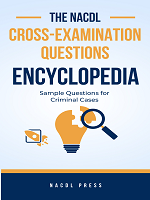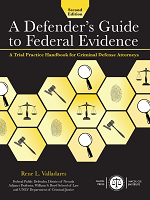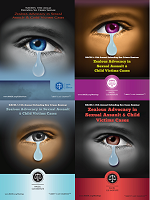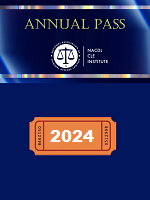Access to The Champion archive is one of many exclusive member benefits. It’s normally restricted to just NACDL members. However, this content, and others like it, is available to everyone in order to educate the public on why criminal justice reform is a necessity.
The importance and prevalence of the hip-hop musical genre within American culture cannot be overstated. From an economic standpoint, for more than three decades, hip-hop has grown to a 10 billion dollar per year industry;1 from an artistic standpoint, the genre has provided an expressive outlet for communities of people of color across America; and from a cultural political standpoint, hip-hop often touches on important issues that we as criminal defense attorneys experience throughout our practices — racism, mass incarceration, and collateral consequences. From Kendrick Lamar’s White House visit with President Obama to Killer Mike campaigning with Bernie Sanders, artists are increasingly utilizing their popularity and platform to shed light on the injustices faced by their communities. But despite the constantly growing popularity and economic success of hip-hop, prosecutors are often ignorant and uninformed about the significance and reality of the genre. These prosecutors often ignore the artistry and refuse to separate fact from fiction, continually utilizing hip-hop lyrics and imagery as factual evidence in cases across the country.
Hip-hop has, since its inception, contained elements of counterculture, anti-authoritarian lyrics, and political criticisms.2 From Public Enemy and NWA in the 1980s to the rise of modern trap music in Atlanta, hip-hop has embodied the political realities of the lives of the artists and shared their experiences with wider communities. As any other musical genre, some aspects of hip-hop are literal and other aspects are illustrative. For example, trap music takes its name from a common term used to describe a place where drugs are sold, i.e., “the trap.”3 But, as rapper/artist Quavarious Marshall, stage name Quavo, describes in his interview with Noisey Atlanta, trap describes a type of mentality and expression from the artists, one where constant and unending work is the only way to success.4 To him, being in the trap does not mean selling drugs out of a house. Rather, it is an embodiment of the work ethic required to be successful in any field.
Counterculture and political critique are not unique to hip-hop, and in fact can be found across myriad genres of music, literature, and art. Yet hip-hop still occupies a difference space than other artistic expression. Prosecutors and judges across the country seem unable or unwilling to separate the symbolism and hyperbole in rap lyrics from the life of the artist. In New Jersey, a man named Vonte Skinner, stage name “Real Threat,” was convicted in 2008 of attempted murder after a detective read 13 pages of Skinner’s lyrics to the jury. It was not until 2014 that the New Jersey Supreme Court ruled that there was an insufficient nexus between the lyrics, which were written years before the crime was committed, and the act in question. The court explained:
The difficulty in identifying probative value in fictional or other forms of artistic self-expressive endeavors is that one cannot presume that, simply because an author has chosen to write about certain topics, he or she has acted in accordance with those views. One would not presume that Bob Marley, who wrote the well-known song “I Shot the Sheriff,” actually shot a sheriff, or that Edgar Allan Poe buried a man beneath his floorboards, as depicted in his short story “The Tell–Tale Heart,” simply because of their respective artistic endeavors on those subjects. Defendant’s lyrics should receive no different treatment. In sum, we reject the proposition that probative evidence about a charged offense can be found in an individual’s artistic endeavors absent a strong nexus between specific details of the artistic composition and the circumstances of the offense for which the evidence is being adduced.5
The New Jersey Supreme Court perfectly highlighted the issue facing hip-hop artists — the disparate treatment between expression in hip-hop and other art forms. In May 2006, the U.S. Attorney’s Office published a bulletin titled “Understanding Gangs and Gang Mentality: Acquiring Evidence of the Gang Conspiracy,” which begins with this premise: “In today’s society, many gang members compose and put their true-life experiences into lyrical form.”6 Nowhere does the bulletin consider that lyrics could be symbolic, hyperbole, or simply artistic expression of the plight of others that the artist has seen in his or her lifetime. It assumes without evidence that lyrics speaking to violence or drug dealing must be reflective of that individual’s personal experience and essentially act as a confession. This sort of bulletin is premised on the idea that certain types of artistic expression can and should be used not just against famous rappers when they are charged with crimes, but every person who matches a specific archetype: young men of color who are suspected gang members. With this bulletin, the people at the U.S. Attorney’s Office are evidencing an intent to uses all means at their disposal, searching websites including YouTube, SoundCloud, Instagram, and Facebook to see if the defendants have created any art that can be twisted into some kind of “confession” to be used against them in subsequent trials. More than that, the bulletin encourages investigators and prosecutors to scour a “suspect’s” social media for any type of expression — even when a suspect is quoting another person’s rap lyrics — for any indication that the “suspect” might be confessing to a murder, might rep a certain gang, or might generally display a character for violence. And yet in any other context, no prosecutor would attempt to enter mere lyrics or even retweets of another’s lyrics as some sort of confession or indictment on the defendant’s character.
Why does hip-hop hold this special place in the artistic world, where rapping about a murder can and often will be used against you? One has difficulty envisioning that, if Johnny Cash were on trial for murder, the fact that he sang that he shot a man in Reno would be used to show his violent tendencies, or that a prosecutor would argue that Al Pacino’s iconic role in Scarface shows he has a history of cocaine trafficking. It is because the hip-hop genre is dominated by young men of color. This kind of evidence is often used to establish gang affiliations, without regard to the fact that many of these young artists grew up in housing projects around drug dealing, street gangs, and rampant violence. Yet as these young men try to convey the life experience of growing up in such areas, law enforcement assumes they must be participating in these acts.7 In fact, in many instances, smaller rap groups and “hybrid gangs” (so deemed by the local authorities) share the same name, and so prosecutors use this (intentionally created) confusion as a way to sneak in “violent” lyrics — even if they would not fit in under the umbrella of confession — as proof of their participation in a gang.8
On one hand, attempting to use rap lyrics as evidence leaves defense attorneys mired in the tangled web of attempting to explain their clients’ violent upbringing, their clients’ need to express themselves through a medium that conveys strength and control because they live in a world where they know they have neither, and their clients’ affiliation with a “label” to better their situation though artistic expression. On the other hand, defense counsel must try to convince the jury that the rap group and the gang are in fact different entities (although the rap lyrics may reference acts of violence to convey strength and status) and that the defendant is merely an artist. It is our role to educate jurors, judges, and prosecutors on this distinction, and to utilize clients’ artistry to their benefit rather than their detriment should the judge make the incorrect decision to admit such lyrics.
One of the best examples of the positive use of hip-hop in the criminal justice system occurred recently at the sentencing of Earl Simmons, whose stage name is DMX. His attorney, NACDL life member Murray Richman, played “Slippin,” a 1998 semi-autobiographical song, to express the hardships Simmons endured growing up and how far the rapper had come from his abusive, impoverished childhood.9 In that case, prosecutors asked the judge to sentence Simmons to five years. Instead, after hearing the song, the judge sentenced Simmons to 12 months.10 Richman demonstrates that by using hip-hop to educate the court on our clients’ lives we can use it as a tool for the defense rather than allowing prosecutors to attempt to use our clients’ artistic expression against them.
We have the responsibility to understand this medium of expression for what it is: free, artistic speech designed to empower our clients. Armed with this understanding, criminal defense lawyers must take on the mantle of educating judges and juries as to the hip-hop genre so that all parties will see it for what it is: a mixture of storytelling, expression, and cultural criticism. As criminal defense lawyers, we should actively discourage the far too often racially motivated attempts by prosecutors to unfairly weaponize this art form. Instead, defense lawyers must present it as evidence not only of racial or hip-hop culture, but additionally as evidence of contemporary American culture.
Notes
- Julie Watson, Hip-Hop: Billion-Dollar Biz (Feb. 24, 2018), available at https://abcnews.go.com/Business/story?id=89840&page=1.
- Andre Douglas Pond Cummings, Thug Life: Hip-Hop’s Curious Relationship with Criminal Justice, 50 Santa Clara L. Rev. 515, 517 (2010).
- Thomas Morton, Noisey Atlanta (2015), available at https://video.vice.com/en_us/video/welcome-to-the-trap/55ce4bb923652a5532d4fbd8.
- Id.
- New Jersey v. Skinner, 218 N.J. 496 (2014).
- Donald Lyddane, Understanding Gangs and Gang Mentality: Acquiring Evidence of the Gang Conspiracy (2006), available at https://www.justice.gov/archive/olp/pdf/gangs.pdf.
- Andrea Dennis, Poetic (In)Justice? Rap Music Lyrics as Art, Life, and Criminal Evidence, 31 Colum. J. L. & Arts 1, 15 (2007).
- Note 5, supra.
- Elizabeth Chuck, ‘Slippin’ Played in Court Before Rapper DMX Gets a Year in Prison for Tax Evasion, (2018), available at https://www.nbcnews.com/pop-culture/pop-culture-news/slippin-played-court-rapper-dmx-gets-year-prison-tax-evasion-n861121.
- United States v. Simmons, No. 1:17-cr-00172-JSR-1 (2018).
About the Author
Drew Findling is principal of The Findling Law Firm, which he founded after serving as an Assistant Public Defender in Fulton County, Georgia. He has tried federal and state criminal cases throughout the United States and has spoken in CLEs in over 40 states. He is a recipient of the Heeney Award, the NAACP’s Civil and Human Rights Award, a commendation by the Legislative Black Caucus of Georgia, and GACDL’s Indigent Defense Award.
Drew Findling (NACDL Life Member)
Findling Law Firm
Atlanta, Georgia
404-460-4500
drew@findlinglawfirm.com
www.findlinglawfirm.com
@drewfindling
@drewfindling






